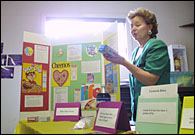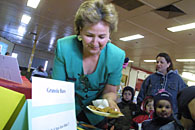Community collaboration
"Our blood is sweet."
 Joyce Rice, part of the Kahnawake Schools Diabetes Prevention Project intervention team, exhibits the nuts and bolts of healthy nutrition that helps prevent diabetes.
Joyce Rice, part of the Kahnawake Schools Diabetes Prevention Project intervention team, exhibits the nuts and bolts of healthy nutrition that helps prevent diabetes.PHOTO: Owen Egan |
|
Joe Jacobs, an elder of the Kanien'keha:ka (Mohawk) community Kahnawake, spelt this message out in Mohawk: "Teiakonekwenhsatsikhe:tare" in a bead wampum belt. He is saying with beads what many have come to realize: Native populations are disproportionately suffering from type 2 diabetes, a disease in which the body can't effectively metabolize sugar.
Under innovative new funding for research partnerships from the Canadian Institutes of Health Research (CIHR), Kahnawake, McGill University and Université de Montréal are collaborating for the Kahnawake Schools Diabetes Prevention Project (KSDPP) Centre for Research & Training in Diabetes Prevention.
The presence of diabetes was rare before the 1940s among Native peoples, and now the rate ranges from 3-5 times the national average. "In some communities, half of the 50-year-olds are diabetic," says Dr. Ann Macaulay, associate professor in family medicine at McGill.
Macaulay has also been a family physician in Kahnawake for three decades. In the early 1980s she worked with the late Dr. Louis Montour, a McGill graduate and Mohawk family physician. "As clinicians," she says, "we knew we were taking care of a lot of people with diabetes." An early chart review showed that 12% of the 45-64-year-olds were diabetic, twice the national average. They shared their findings with the rest of Kahnawake.
Amelia McGregor was at the initial presentation. "The fire bells were ringing from Drs. Macaulay and Montour, raising the alarm that diabetes is on the rise in the community," she says. "The discussion around the table was 'What are we going to do? How do we get the message out?' The one common denominator was that everyone's willing to go the distance for the children."
The original KSDPP was formed in 1994, and is made up of three partners: the Community Advisory Board, of which McGregor is a member, the community researchers, and academic researchers from McGill University (Dr. Gilles Paradis from Epidemiology, Biostatistics and Community Health) and Université de Montréal. Other McGill staff who joined the new KSDPP Centre in 2001 include nutritionist Dr. Katherine Gray-Donald and associate dean of graduate studies and research and member of the Institutional Review Boards Dr. Robert Mackenzie, who represents McGill University on the Supervisory Committee.
KSDPP's focus is the primary prevention of type 2 diabetes by promoting physical activity, healthy eating and maintaining a normal body weight, all key in fighting the disease. They have developed and introduced a health curriculum which is delivered in Mohawk and English from Grades 1-6. Schools now have a healthy nutrition policy banning junk food, cooking classes for parents, and teachers walk with the kids. KSDPP hopes to extend the new 1.2 km recreation path, and convince more places to only sell healthy food.
 |
|
They also want to spread the message about the prevalence of diabetes to other Native communities. Participants like Jacobs play important roles in encouraging action. He has travelled on foot, by bicycle and across Lake Simcoe by canoe to different communities, delivering his wampum belts with the words meaning "our blood is sweet." As arduous as these trips may be, he says, "I always keep our children in mind, our future." Why not drive there, or pop it in the mail? "Part of the message is to be more active."
Wampum belts were traditionally used to incorporate messages of agreement between people, he explains. He tells communities to "push all conflicts aside because this is for the children." Thanks to his efforts, others have heeded the message and started their own diabetes programs.
Native ancestry is a risk factor for diabetes. Some indigenous groups are more susceptible than others, Macaulay explains, such as Australian Aborigines, New Zealand Maoris, and many native groups in North America. One accepted, but still unproven, explanation suggests the presence of a "thrifty" gene in native peoples, which promotes rapid intake and storage of energy -- necessary for hunter-gatherers. Also, distribution of fat around the abdomen means energy is readily available for vital organs. With the rapid dietary and lifestyle adjustment to non-native ways (processed food, refined sugar, and a sedentary way of living) native metabolism was thrown out of whack.
Other risk factors include the disease already being present in the family, being overweight, being sedentary, bad eating habits and, possibly, stress. Kids who were primarily bottle-fed and whose mothers had gestational diabetes are also at higher risk.
In 1994, KSDPP surveyed school kids from Grades 1-6 and compared them with other North American children. They used anthropometric measures (height/weight and waist/hip ratios; skinfold thickness), fitness tests, questionnaires for physical activity and TV watching and getting them to recall what they ate in the last day.
The Kahnawake kids weighed about the same as other North American kids (but the heavy ones were heavier), had similar levels of TV watching (too much: one quarter watching over 4 programs a day) and fitness and activity (not enough). Kahnawake's children ate the right amount of fat, but too much sugar, and fewer than five servings of fruit and vegetables a day.
In 1998, the tests were done again. The upshot? Less soda, but more candy, was consumed. Kids weighed the same as in 1994 (which is good: the rest of North America got heavier), and overall they practiced healthier eating, increased activity, and boys watched less Saturday-morning TV.
Other findings include that in Kahnawake girls, excess weight is associated with increased TV watching, but not among boys, who are more physically active. Also, boys feel that their parents "encourage" them to be active, whereas girls feel parents "tell" them to be active.
Although ostensibly for kids, adults are more active too. "You now see people in the community going for walks," says Macaulay. McGregor is "personally more aware and conscious of promoting activity and eating nutritious food." She also leaves the car behind more often. "It's those little steps," she says. For her family she's "making sure every meal is a little bit better planned. If you're going to have a big piece of cake, have a salad for supper. Or if you're going to have chicken and mashed potatoes, don't have dessert." It's all about balance, she adds.
Because Kahnawake has always been in the middle of other non-Native communities, such as Montreal and the States, McGregor says Mohawks are open to dialogue, yet strong against outside influences. For KSDPP, the Community Advisory Board oversees cultural, spiritual and political aspects of the project. One task is to make sure "if KSDPP going to recommend an activity or nutritional food, it has to be something that the people will recognize and accept." Hence the schools emphasize traditional foods like corn, beans and squash, and promote lacrosse and walking. "Walking came from the idea of designated runners who took messages from one community to another," McGregor says. "It's what people understand."
The five-year (2001-2006) CIHR funding will let KSDPP do a 10-year follow-up, Macaulay says, and examine why the project has been successful. KSDPP will also provide a training ground for academics and researchers in diabetes prevention projects (with priority given to aboriginal candidates) and evaluate how the KSDPP model is adapted by other Native communities.
Small signs for healthy living are adding up. The slush machine in the youth centre "broke down" a couple of years ago and, well, it just hasn't been fixed. Macaulay laughs, saying the company's a bit distraught, as that used to be one of their most profitable locales.

